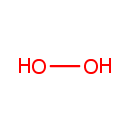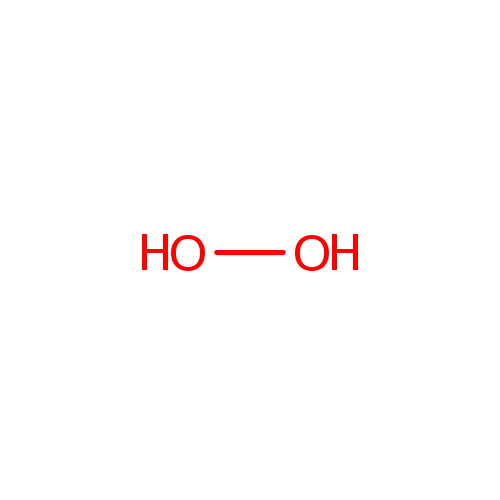
Hydrogen peroxide (PAMDB001640)
| Record Information | ||||||||||||||||||||||||||||||||||||||||||||||||||||
|---|---|---|---|---|---|---|---|---|---|---|---|---|---|---|---|---|---|---|---|---|---|---|---|---|---|---|---|---|---|---|---|---|---|---|---|---|---|---|---|---|---|---|---|---|---|---|---|---|---|---|---|---|
| Version | 1.0 | |||||||||||||||||||||||||||||||||||||||||||||||||||
| Update Date | 1/22/2018 11:54:54 AM | |||||||||||||||||||||||||||||||||||||||||||||||||||
| Metabolite ID | PAMDB001640 | |||||||||||||||||||||||||||||||||||||||||||||||||||
| Identification | ||||||||||||||||||||||||||||||||||||||||||||||||||||
| Name: | Hydrogen peroxide | |||||||||||||||||||||||||||||||||||||||||||||||||||
| Description: | Hydrogen peroxide (H2O2) is the simplest peroxide (a compound with an oxygen-oxygen single bond). It is also a strong oxidizer. Hydrogen peroxide is a clear liquid, slightly more viscous than water. The oxidizing capacity of hydrogen peroxide is so strong that it is considered a highly reactive oxygen species. Organisms also naturally produce hydrogen peroxide as a by-product of oxidative metabolism. Consequently, nearly all living things (specifically, all obligate and facultative aerobes) possess enzymes known as catalase peroxidases, which harmlessly and catalytically decompose low concentrations of hydrogen peroxide to water and oxygen. (Wikipedia) Hydrogen peroxide (H2O2) is a very pale blue liquid which appears colourless in a dilute solution, slightly more viscous than water. It is a weak acid. It has strong oxidizing properties and has also found use as a disinfectant and as an oxidizer. Hydrogen peroxide (H2O2) is a well-documented component of living cells. It plays important roles in host defense and oxidative biosynthetic reactions. In addition, there is growing evidence that at low levels, H2O2 also functions as a signaling agent, particularly in higher organisms. (HMDB) In Pseudomonas aeruginosa, H2O2 is used in the aerobic degradation of L-ascorbate, and produced as a byproduct in many reactions involving oxygen as an oxidizing agent. (EcoCyc) In Pseudomonas aeruginosa glyoxylate metabolism, H2O2 is produced as a byproduct of the conversion of glycolate to glyoxylate by the enzyme glycolate oxidase (EC 1.1.3.15), and H2O2 is then converted to harmless O2 by the enzyme catalase (EC 1.11.1.6). (KEGG) | |||||||||||||||||||||||||||||||||||||||||||||||||||
| Structure | ||||||||||||||||||||||||||||||||||||||||||||||||||||
| Synonyms: |
| |||||||||||||||||||||||||||||||||||||||||||||||||||
| Chemical Formula: | H2O2 | |||||||||||||||||||||||||||||||||||||||||||||||||||
| Average Molecular Weight: | 34.0147 | |||||||||||||||||||||||||||||||||||||||||||||||||||
| Monoisotopic Molecular Weight: | 34.005479308 | |||||||||||||||||||||||||||||||||||||||||||||||||||
| InChI Key: | MHAJPDPJQMAIIY-UHFFFAOYSA-N | |||||||||||||||||||||||||||||||||||||||||||||||||||
| InChI: | InChI=1S/H2O2/c1-2/h1-2H | |||||||||||||||||||||||||||||||||||||||||||||||||||
| CAS number: | 7722-84-1 | |||||||||||||||||||||||||||||||||||||||||||||||||||
| IUPAC Name: | peroxol | |||||||||||||||||||||||||||||||||||||||||||||||||||
| Traditional IUPAC Name: | hydrogen peroxide | |||||||||||||||||||||||||||||||||||||||||||||||||||
| SMILES: | OO | |||||||||||||||||||||||||||||||||||||||||||||||||||
| Chemical Taxonomy | ||||||||||||||||||||||||||||||||||||||||||||||||||||
| Taxonomy Description | This compound belongs to the class of inorganic compounds known as homogeneous other non-metal compounds. These are inorganic non-metallic compounds in which the largest atom belongs to the class of 'other nonmetals'. | |||||||||||||||||||||||||||||||||||||||||||||||||||
| Kingdom | Inorganic compounds | |||||||||||||||||||||||||||||||||||||||||||||||||||
| Super Class | Homogeneous non-metal compounds | |||||||||||||||||||||||||||||||||||||||||||||||||||
| Class | Homogeneous other non-metal compounds | |||||||||||||||||||||||||||||||||||||||||||||||||||
| Sub Class | Not Available | |||||||||||||||||||||||||||||||||||||||||||||||||||
| Direct Parent | Homogeneous other non-metal compounds | |||||||||||||||||||||||||||||||||||||||||||||||||||
| Alternative Parents | Not Available | |||||||||||||||||||||||||||||||||||||||||||||||||||
| Substituents |
| |||||||||||||||||||||||||||||||||||||||||||||||||||
| Molecular Framework | Acyclic compounds | |||||||||||||||||||||||||||||||||||||||||||||||||||
| External Descriptors |
| |||||||||||||||||||||||||||||||||||||||||||||||||||
| Physical Properties | ||||||||||||||||||||||||||||||||||||||||||||||||||||
| State: | Liquid | |||||||||||||||||||||||||||||||||||||||||||||||||||
| Charge: | 0 | |||||||||||||||||||||||||||||||||||||||||||||||||||
| Melting point: | -0.43 °C | |||||||||||||||||||||||||||||||||||||||||||||||||||
| Experimental Properties: |
| |||||||||||||||||||||||||||||||||||||||||||||||||||
| Predicted Properties |
| |||||||||||||||||||||||||||||||||||||||||||||||||||
| Biological Properties | ||||||||||||||||||||||||||||||||||||||||||||||||||||
| Cellular Locations: | Cytoplasm | |||||||||||||||||||||||||||||||||||||||||||||||||||
| Reactions: | Hydrogen peroxide + Reduced Thioredoxin >2 Water + Oxidized Thioredoxin 2 Hydrogen peroxide <>2 Water + Oxygen 2 Hydrogen ion + 2 Superoxide anion > Hydrogen peroxide + Oxygen Water + Oxygen + Sarcosine > Formaldehyde + Glycine + Hydrogen peroxide N-Methyltryptophan + Water + Oxygen > Formaldehyde + Hydrogen peroxide + L-Tryptophan gamma-Glutamyl-L-putrescine + Water + Oxygen > gamma-Glutamyl-gamma-butyraldehyde + Hydrogen peroxide + Ammonium Dopamine + Water + Oxygen > 3,4-Dihydroxyphenylacetaldehyde + Hydrogen peroxide + Ammonium Water + Oxygen + Tyramine > 4-Hydroxyphenylacetaldehyde + Hydrogen peroxide + Ammonium Water + Oxygen + Phenylethylamine > Hydrogen peroxide + Ammonium + Phenylacetaldehyde Water + Oxygen + Pyridoxamine 5'-phosphate > Hydrogen peroxide + Ammonium + Pyridoxal 5'-phosphate 2 Glutathione + Hydrogen peroxide <> Glutathione disulfide +2 Water L-Aspartic acid + Oxygen <> Hydrogen ion + Hydrogen peroxide + Iminoaspartic acid Hydrogen peroxide + L-Methionine > Water + Methionine sulfoxide 2 [4Fe-4S] iron-sulfur cluster + 2 Hydrogen ion + Hydrogen peroxide >2 [3Fe-4S] damaged iron-sulfur cluster +2 Fe3+ +2 Water Pyridoxamine 5'-phosphate + Water + Oxygen <> Pyridoxal 5'-phosphate + Ammonia + Hydrogen peroxide L-Aspartic acid + Water + Oxygen <> Oxalacetic acid + Ammonia + Hydrogen peroxide Glycolic acid + Oxygen <> Glyoxylic acid + Hydrogen peroxide L-Aspartic acid + Oxygen <> Iminoaspartic acid + Hydrogen peroxide Methanol + Hydrogen peroxide <> Formaldehyde +2 Water Pyridoxamine + Water + Oxygen <> Pyridoxal + Ammonia + Hydrogen peroxide More...Pyridoxine + Oxygen <> Pyridoxal + Hydrogen peroxide Tyramine + Water + Oxygen <> 4-Hydroxyphenylacetaldehyde + Ammonia + Hydrogen peroxide Aminoacetone + Water + Oxygen <> Pyruvaldehyde + Ammonia + Hydrogen peroxide Phenylethylamine + Oxygen + Water <> Phenylacetaldehyde + Ammonia + Hydrogen peroxide 2 3-Hydroxyanthranilic acid + 4 Oxygen <> Cinnavalininate +2 Superoxide anion +2 Hydrogen peroxide +2 Hydrogen ion 1,3-Diaminopropane + Oxygen + Water <> 3-Aminopropionaldehyde + Ammonia + Hydrogen peroxide Dopamine + Water + Oxygen <> 3,4-Dihydroxyphenylacetaldehyde + Ammonia + Hydrogen peroxide gamma-Glutamyl-L-putrescine + Water + Oxygen <> gamma-Glutamyl-gamma-butyraldehyde + Ammonia + Hydrogen peroxide Hydrogen ion + Hydrogen peroxide + Iron > hydroxyl radical + OH<SUP>-</SUP> + Fe<SUP>3+</SUP> dehydroascorbate (bicyclic form) + Hydrogen peroxide > L-threonate + Oxalic acid + Hydrogen ion Ascorbic acid + Hydrogen peroxide > monodehydroascorbate + Water Heme + Hydrogen peroxide Heme D NAD(P)H + Cr<sup>6+</sup> + Oxygen > NAD(P)<sup>+</sup> + Cr<sup>3+</sup> + Hydrogen peroxide L-Methionine + Hydrogen peroxide > L-methionine <i>S</i>-oxide + Water Aminoacetone + Water + Oxygen > Hydrogen ion + Pyruvaldehyde + Ammonia + Hydrogen peroxide an aliphatic amine + Water + Oxygen > an aldehyde + Ammonia + Hydrogen peroxide + Hydrogen ion Water + Oxygen + Phenylethylamine > Hydrogen ion + Hydrogen peroxide + Ammonia + Phenylacetaldehyde L-Malic acid + Oxygen <> Oxalacetic acid + Hydrogen peroxide a phenolic donor + Hydrogen peroxide a phenoxyl radical of a phenolic donor + Water Oxygen + Water + Pyridoxamine 5'-phosphate > Hydrogen ion + Hydrogen peroxide + Ammonia + Pyridoxal 5'-phosphate Oxygen + Pyridoxine 5'-phosphate > Hydrogen peroxide + Pyridoxal 5'-phosphate Protoporphyrinogen IX + Oxygen > Protoporphyrin IX + Hydrogen peroxide a reduced electron acceptor + Hydrogen peroxide > an oxidized electron acceptor + Water Ascorbic acid + Hydrogen peroxide + Hydrogen ion > Ascorbic acid + L-dehydro-ascorbate + Water a primary amine + Water + Oxygen > an aldehyde + Ammonia + Hydrogen peroxide L-2-Hydroxyglutaric acid + Oxygen > Oxoglutaric acid + Hydrogen peroxide RCH(2)NH(2) + Water + Oxygen > RCHO + Ammonia + Hydrogen peroxide 2 Iron + Hydrogen peroxide + 2 Hydrogen ion >2 Fe3+ +2 Water Donor + Hydrogen peroxide > oxidized donor +2 Water (S)-2-hydroxy acid + Oxygen > 2-oxo acid + Hydrogen peroxide 2 superoxide + 2 Hydrogen ion > Oxygen + Hydrogen peroxide 2 Ferrocytochrome c + Hydrogen peroxide >2 Ferricytochrome c +2 Water Reduced acceptor + Hydrogen peroxide <> Acceptor + Water + Oxygen Primary amine + Water + Oxygen <> Aldehyde + Ammonia + Hydrogen peroxide Pyridoxamine 5'-phosphate + Water + Oxygen + Pyridoxine 5'-phosphate <> Pyridoxal 5'-phosphate + Ammonia + Hydrogen peroxide (S)-2-Hydroxyacid + Oxygen <> 2-Oxo acid + Hydrogen peroxide L-Aspartic acid + Water + Oxygen + L-Aspartic acid > Oxalacetic acid + Ammonia + Hydrogen peroxide L-Aspartic acid + Oxygen + L-Aspartic acid > Hydrogen peroxide + Hydrogen ion + Iminoaspartic acid gamma-Glutamyl-L-putrescine + Oxygen + Water > 4-(γ-glutamylamino)butanal + Ammonium + Hydrogen peroxide ferroheme b + Hydrogen peroxide > Heme D | |||||||||||||||||||||||||||||||||||||||||||||||||||
| Pathways: |
| |||||||||||||||||||||||||||||||||||||||||||||||||||
| Spectra | ||||||||||||||||||||||||||||||||||||||||||||||||||||
| Spectra: |
| |||||||||||||||||||||||||||||||||||||||||||||||||||
| References | ||||||||||||||||||||||||||||||||||||||||||||||||||||
| References: |
| |||||||||||||||||||||||||||||||||||||||||||||||||||
| Synthesis Reference: | Not Available | |||||||||||||||||||||||||||||||||||||||||||||||||||
| Material Safety Data Sheet (MSDS) | Download (PDF) | |||||||||||||||||||||||||||||||||||||||||||||||||||
| Links | ||||||||||||||||||||||||||||||||||||||||||||||||||||
| External Links: |
| |||||||||||||||||||||||||||||||||||||||||||||||||||
Enzymes
- General function:
- Involved in superoxide dismutase activity
- Specific function:
- Destroys radicals which are normally produced within the cells and which are toxic to biological systems
- Gene Name:
- sodA
- Locus Tag:
- PA4468
- Molecular weight:
- 22.5 kDa
Reactions
| 2 superoxide + 2 H(+) = O(2) + H(2)O(2). |
- General function:
- Involved in antioxidant activity
- Specific function:
- 2 R'-SH + ROOH = R'-S-S-R' + H(2)O + ROH
- Gene Name:
- bcp
- Locus Tag:
- PA1008
- Molecular weight:
- 17.4 kDa
Reactions
| 2 R'-SH + ROOH = R'-S-S-R' + H(2)O + ROH. |
- General function:
- Involved in catalytic activity
- Specific function:
- Specific function unknown
- Gene Name:
- glcD
- Locus Tag:
- PA5355
- Molecular weight:
- 53.7 kDa
- General function:
- Involved in superoxide dismutase activity
- Specific function:
- Destroys radicals which are normally produced within the cells and which are toxic to biological systems
- Gene Name:
- sodB
- Locus Tag:
- PA4366
- Molecular weight:
- 21.4 kDa
Reactions
| 2 superoxide + 2 H(+) = O(2) + H(2)O(2). |
- General function:
- Involved in electron carrier activity
- Specific function:
- Catalyzes the oxidation of L-aspartate to iminoaspartate
- Gene Name:
- nadB
- Locus Tag:
- PA0761
- Molecular weight:
- 60 kDa
Reactions
| L-aspartate + O(2) = iminosuccinate + H(2)O(2). |
- General function:
- Involved in catalase activity
- Specific function:
- Decomposes hydrogen peroxide into water and oxygen; serves to protect cells from the toxic effects of hydrogen peroxide
- Gene Name:
- katE
- Locus Tag:
- PA2147
- Molecular weight:
- 78 kDa
Reactions
| 2 H(2)O(2) = O(2) + 2 H(2)O. |
- General function:
- Involved in malate dehydrogenase (quinone) activity
- Specific function:
- (S)-malate + a quinone = oxaloacetate + reduced quinone
- Gene Name:
- mqo
- Locus Tag:
- PA3452
- Molecular weight:
- 57.2 kDa
Reactions
| (S)-malate + a quinone = oxaloacetate + reduced quinone. |
- General function:
- Involved in oxidoreductase activity
- Specific function:
- Involved in the breakdown of putrescine via the oxidation of L-glutamylputrescine
- Gene Name:
- puuB
- Locus Tag:
- PA2776
- Molecular weight:
- 46.7 kDa
Reactions
| Gamma-glutamylputrescine + H(2)O + O(2) = Gamma-glutamyl-gamma-aminobutyraldehyde + NH(3) + H(2)O(2). |
- General function:
- Involved in iron-sulfur cluster binding
- Specific function:
- Specific function unknown
- Gene Name:
- glcF
- Locus Tag:
- PA5353
- Molecular weight:
- 44.7 kDa
- General function:
- Involved in catalytic activity
- Specific function:
- Specific function unknown
- Gene Name:
- glcE
- Locus Tag:
- PA5354
- Molecular weight:
- 38.2 kDa
- General function:
- Involved in electron carrier activity
- Specific function:
- Participates in various redox reactions through the reversible oxidation of its active center dithiol to a disulfide and catalyzes dithiol-disulfide exchange reactions
- Gene Name:
- trxA
- Locus Tag:
- PA5240
- Molecular weight:
- 11.9 kDa
- General function:
- Coenzyme transport and metabolism
- Specific function:
- Catalyzes the oxidation of either pyridoxine 5'- phosphate (PNP) or pyridoxamine 5'-phosphate (PMP) into pyridoxal 5'-phosphate (PLP)
- Gene Name:
- pdxH
- Locus Tag:
- PA1049
- Molecular weight:
- 24.9 kDa
Reactions
| Pyridoxamine 5'-phosphate + H(2)O + O(2) = pyridoxal 5'-phosphate + NH(3) + H(2)O(2). |
| Pyridoxine 5'-phosphate + O(2) = pyridoxal 5'-phosphate + H(2)O(2). |

